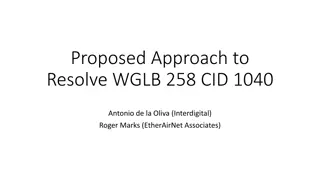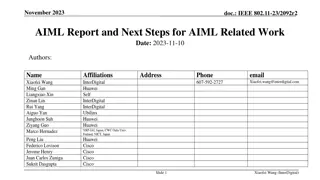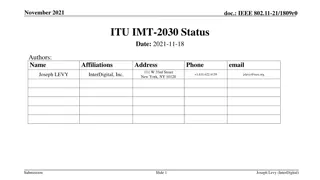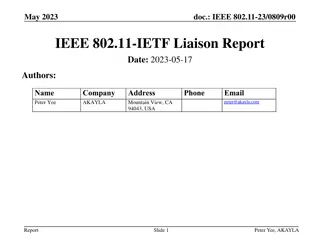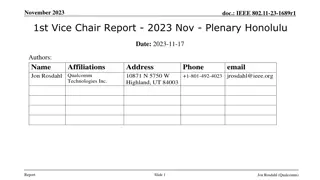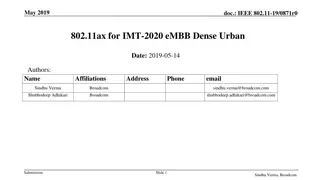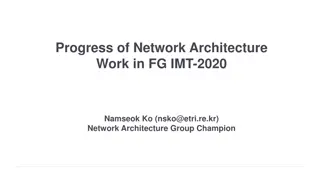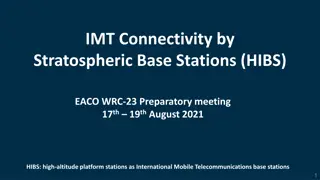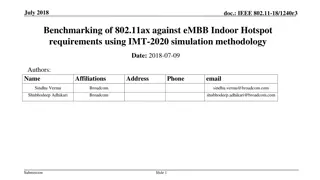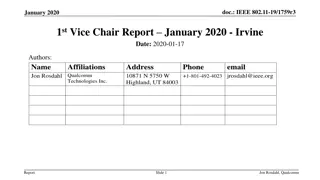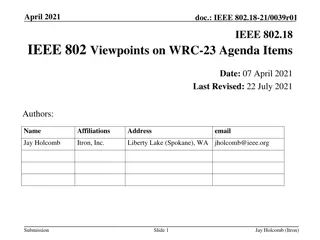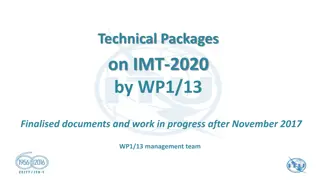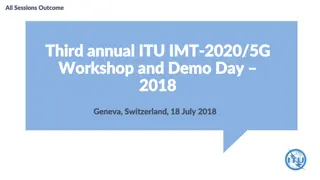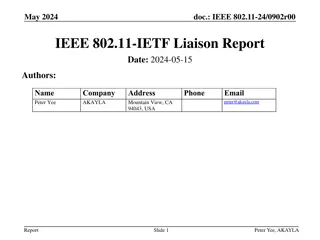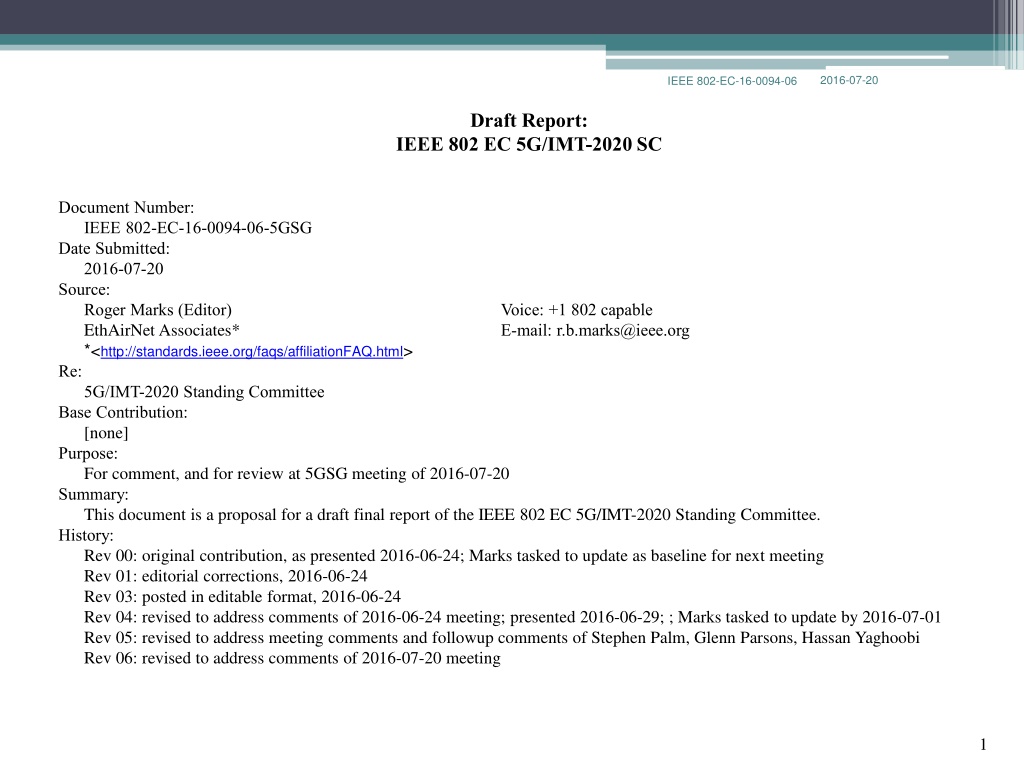
IEEE 802 EC 5G/IMT-2020 Standing Committee Draft Report
This draft report presents the proposal for the IEEE 802 EC 5G/IMT-2020 Standing Committee, outlining its purpose, history, and content including authorized scope, views of 5G, and next steps. The report covers the cost/benefits of creating an IEEE 5G specification and providing a proposal for IMT-2020, as well as acting as a communication point with other IEEE organizations on the topic.
Download Presentation

Please find below an Image/Link to download the presentation.
The content on the website is provided AS IS for your information and personal use only. It may not be sold, licensed, or shared on other websites without obtaining consent from the author. If you encounter any issues during the download, it is possible that the publisher has removed the file from their server.
You are allowed to download the files provided on this website for personal or commercial use, subject to the condition that they are used lawfully. All files are the property of their respective owners.
The content on the website is provided AS IS for your information and personal use only. It may not be sold, licensed, or shared on other websites without obtaining consent from the author.
E N D
Presentation Transcript
2016-07-20 IEEE 802-EC-16-0094-06 Draft Report: IEEE 802 EC 5G/IMT-2020 SC Document Number: IEEE 802-EC-16-0094-06-5GSG Date Submitted: 2016-07-20 Source: Roger Marks (Editor) EthAirNet Associates* *<http://standards.ieee.org/faqs/affiliationFAQ.html> Re: 5G/IMT-2020 Standing Committee Base Contribution: [none] Purpose: For comment, and for review at 5GSG meeting of 2016-07-20 Summary: This document is a proposal for a draft final report of the IEEE 802 EC 5G/IMT-2020 Standing Committee. History: Rev 00: original contribution, as presented 2016-06-24; Marks tasked to update as baseline for next meeting Rev 01: editorial corrections, 2016-06-24 Rev 03: posted in editable format, 2016-06-24 Rev 04: revised to address comments of 2016-06-24 meeting; presented 2016-06-29; ; Marks tasked to update by 2016-07-01 Rev 05: revised to address meeting comments and followup comments of Stephen Palm, Glenn Parsons, Hassan Yaghoobi Rev 06: revised to address comments of 2016-07-20 meeting Voice: +1 802 capable E-mail: r.b.marks@ieee.org 1
2 2016-07-20 IEEE 802-EC-16-0094-06 Proposed DraftReport: IEEE802EC5G/IMT-2020SC Draft Report: 5G/IMT-2020 Standing Committee of IEEE 802 Executive Committee 20 July2016
3 Table of Contents 2016-07-20 IEEE 802-EC-16-0094-06 Introduction Authorized Scope Views of 5G Actions Considered A. IEEE 5G B1. IMT-2020 single technology B2. IMT-2020 set of technologies B3. IMT-2020 external proposal Conclusions Next Steps Appendices Appendix 1: Authorization by EC Ballot Appendix 2: Meeting History Appendix 3: Process Appendix 4: Cost/Benefit Approach Appendix 5: Relevant IEEE 802 Standards and Projects
4 2016-07-20 IEEE 802-EC-16-0094-06 Introduction The IEEE 802 EC 5G/IMT-2020 Standing Committee was chartered (Feb - July 2016) by EC ballot see Appendix 1 Glenn Parsons served as Chair The Standing Committee held face-to-face and electronic meetings see Appendix 2 documents: https://mentor.ieee.org/802-ec/documents?is_group=5GSG Standing Committee web site: http://ieee802.org/Stand_Com/5G This document provides the requested report
5 2016-07-20 IEEE 802-EC-16-0094-06 Authorized Scope Toprovideareportonthefollowingitemstothe EC: CostsandbenefitsofcreatinganIEEE5Gspecification CostsandbenefitsofprovidingaproposalforIMT- 2020,consideringpossiblemodelsofaproposal: asasingletechnology, asasetoftechnologies, orasoneormoretechnologieswithinaproposal fromexternal bodies(e.g.,3GPP) Duringitslifetime,toactasthecommunication point withotherIEEEorganizationsonthis topic.
6 2016-07-20 IEEE 802-EC-16-0094-06 Views of 5G 5G is understood many ways. Facets that distinguish 5G may include: Technology: radical new technologies or technology sets could include spectrum-related technology issues millimeter wave spectrum technologies designed for unlicensed use Service: provides new services or new service sets Performance: new levels of performance to users, or to operators Operator ecosystem, either: next step for the existing 2G/3G/4G incumbent mobile operators an opportunity for new operators Standards: set of interoperability standards rolled out by an ecosystem according to a roadmap Other Characteristic: a marketing label, a revolution, etc. Scope of an IEEE 5G specification would likely differ from scope of other 5G endeavors.
7 2016-07-20 IEEE 802-EC-16-0094-06 5G Context for this study Action A: creating an IEEE 5G specification could support incumbent mobile operators via existing cellular ecosystem could support new operators creation/support of new ecosystems this might be a very different 5G would need to identify requirements could do both Action B: providing a proposal for IMT-2020 supports the 5G of the existing cellular ecosystem usage scenarios and requirements specified in IMT-2020 process 802 could help shape requirements (needs to act soon) Actions A and B are not contradictory or exclusive
8 2016-07-20 IEEE 802-EC-16-0094-06 IMT-2020 (per ITU-R M.2083)
9 2016-07-20 IEEE 802-EC-16-0094-06 COST BENEFIT ANALYSIS OF OPTIONS/ACTIONS
10 2016-07-20 IEEE 802-EC-16-0094-06 Action A: IEEE 5G specification Candidate Approach specify an 802 access network could be based on P802.1CF network reference model defines a generic foundation for the description of IEEE 802 access networks, which may include multiple network interfaces, multiple network access technologies, and multiple network subscriptions, aimed at unifying the support of different interface technologies, enabling shared network control and use of software-defined networking (SDN) principles provides an external view into general 802 access network could support many 802 MACs could plug into incumbent mobile operator networks for example, expand the notion of LWA so that the cellular network supports 802 rather than 802.11 gives 802 a strong supporting role in cellular 5G networks could support integration into other operator networks e.g. cable TV or fixed telecom gives 802 a central role in non-cellular 5G networks feasible for 802 access network to support both need not promote it as an IEEE 5G network
11 2016-07-20 IEEE 802-EC-16-0094-06 P802.1CF Interface option to 5G Source: IEEE 802-EC-16-0083-00-5GSG
12 Action A: Routes to success 802 Access Network 2016-07-20 IEEE 802-EC-16-0094-06 engage with 3GPP to specify interface details could support many 802 MACs engage with other parties to specify interface details build partnership with other operator communities support internationalization standardize within partner communities standardize in JTC1 standardize in ITU-R (WP 5A) in support of spectrum needs WP 5A: Land mobile service excluding IMT refer to WP 5A s Guide to the use of ITU-R texts relating to the land mobile service, including wireless access in the fixed service could standardize in ITU-R IMT-2020 (see Action B)
13 Action A: Possible partners 802 Access Network 2016-07-20 IEEE 802-EC-16-0094-06 IEEE Communications Society standards activities; e.g. IEEE 1904 Access Networks Working Group 3GPP ITU-R (WP 5A; WP 5D) IETF, Broadband Forum, CableLabs, MEF, ETSI BRAN, Open Networking Foundation, Wi-Fi Alliance, ZigBee Alliance, Ethernet Alliance, WiMAX Forum, CPRI,
14 2016-07-20 IEEE 802-EC-16-0094-06 Action A IEEE802 Access Network Objective Strength Opportunity Weakness Threat Adoption of IEEE 802 Access Network specification in multiple disparate operator networks. 1. Builds on traditional 802 presentation of interface to support many networks 1. Could require compromises in the support of any specific network 1. Can be applied in both 3GPP networks and in alternative networks 1. Coordination efforts required may not be accepted 2. Requires liaison activity to coordinate interface requirements. 2. Specifications may come too late or under-perform 2. Enhances interoperation with identified end-to- end networks 2. Offers an advantage for end- to-end networks to use 802 Description 3. Could be leveraged to promote spectrum for non-IMT systems; e.g. WAS 3. May require development of uses cases and requirements 3. Increases value of the entire range of 802 MAC/PHYs; could support spectrum expansion 3. Non-802 technologies may be used at the specified interface Specify an IEEE 802 Access Network, incorporating IEEE 802 MAC/PHYs and supporting standards, with a unified interface to end- to-end networks. Promote standardization of the integration of the IEEE 802 Access Network into end-to- end networks. Cost Benefit IEEE 802 needs to develop Access Network spec; 802 MAC/PHYs may need to develop new amendments; external ecosystems need to be developed Makes IEEE 802 the central player in heterogeneous access and in access networks for 5G of all forms; IEEE has no responsibility to specify end-to-end
15 Action B: IMT-2020 proposal Candidate Approaches 2016-07-20 IEEE 802-EC-16-0094-06 B1: Direct IMT-2020 single technology Develop and submit an IEEE proposal to adopt some IEEE 802.11 radio interface technology into IMT-2020 RIT. B2: Direct IMT-2020 set of technologies Develop and submit an IEEE proposal to adopt coherent set of IEEE 802 radio interface technologies into IMT-2020 RIT, possibly integrated in an IEEE 802 Access Network. B3: IMT-2020 external body proposal Support development of a 3GPP proposal incorporating references to the use of IEEE 802.11, or an IEEE 802 Access Network.
16 Action B1: single technology Candidate Approach: more detail 2016-07-20 IEEE 802-EC-16-0094-06 IEEE 802.11 radio interface technology based on IEEE P802.11ay Addressing eMBB usage scenario Targeting indoor hotspot test environment
17 Action B3: external partner proposal Candidate Approach: more detail Support development of a 3GPP proposal incorporating reference to the use of IEEE 802.11, or an IEEE 802 Access Network. Reference 802 network presumed to operate in non-IMT bands for example, 802.11ax in 5 GHz bands, 802.11ay in 60 GHz, etc. for example, evolution of LWA, eLWA, LWIP would not be proposed as IMT-2020 RIT Does not preclude parallel action B1 or B2 to propose IMT-2020 RIT Serves as a feature enhancement to 3GPP network operation not evaluated against IMT-2020 technical requirements 3GPP meets IMT-2020 technical requirements with 3GPP SRIT requires technical analysis to select appropriate architectural models for integration with 3GPP network Identify Interfaces to IEEE 802 technologies requires coordination with 3GPP on details 2016-07-20 IEEE 802-EC-16-0094-06
2016-07-20 IEEE 802-EC-16-0094-06 Potential 3GPP NextGen Core & New RAT 3GPP is developing a new 5G New RAT (NR) and a new 5G Core Network ( NextGen Core ) Several candidate architectures might allow 802.11 integration into 3GPP 5G network, e.g.: (1) 802.11 WLAN interfaces directly to NextGen Core (2) 802.11 WLAN interfaces with NR base station, e.g., similar to dual connectivity architecture used by LWA/eLWA/LWIP [see R2-163969] (3) 802.11 WLAN data plane interfaces with NR base station, while control plane interfaces with NextGen Core Source: IEEE 802-EC-16-0099-01-5GSG
2016-07-20 IEEE 802-EC-16-0094-06 Integration of 802.11 in 3GPP 5G networks Different architectures may suit different operator deployments and use cases, e.g. Some architectures imply increased load on backhaul Dual connectivity architectures may not allow for macro coverage if NR base station operates at higher frequency than WLAN Availability of specifications for the different architectures depends on future 3GPP progress, decisions and specification timeline Out of the control of IEEE Commercial deployment of the different architectures depends on handset vendor roadmaps, cellular infrastructure vendor roadmaps and network operator decisions Out of the control of IEEE Any technical activities for 5G undertaken by 802 should focus on enablers / building blocks / interfaces that are as generic as possible and can be utilized by any architecture. Consider gap analysis for any necessary specification work
20 2016-07-20 IEEE 802-EC-16-0094-06 Action B1 IMT-2020 proposal, single technology Opportunity Objective Strength Weakness Threat IMT-2020 recognition for some IEEE 802.11 radio interface. 1. An 802.11 radio interface can be recognized as IMT- 2020 1. Difficult application process; may require new standards to meet requirements 1. IMT-2020 recognition can add marketing value 1. May become more difficult to convince regulators to identify more RLAN spectrum 2. Allows independent IEEE proposal 2. Requires 3GPP to agree to merge result into a SRIT 2. Allows 802.11 to optimize proposal 2. 3GPP may prefer alternative and may not agree Description 3. Allows IEEE to propose use of unlicensed technology for IMT 3. Unclear how technologies built for unlicensed use would fit into IMT spectrum 3. IMT recognition can promote use of that 802.11 radio interface in IMT spectrum 3. RIT simulation modeling required by ITU-R may fail to produce convincing results Develop and submit an IEEE proposal to adopt some form of IEEE 802.11 radio interface technology into IMT-2020. Cost Benefit Developing standards, preparing and pitching proposal, developing administration support, supporting evaluations, negotiating SRIT, perpetual maintenance Marketing value. Possibility of better access to spectrum, particularly by targeting a specific segment of new mm- wave spectrum to be identified for IMT
21 2016-07-20 IEEE 802-EC-16-0094-06 Action B2 IMT-2020 proposal, set of technologies Objective Objective Strength Opportunity Weakness Threat IMT-2020 recognition for several IEEE 802 radio interfaces. 1. 802 radio interfaces can be recognized as IMT- 2020 1. Difficult application process; may require new stds, and internal coordination, to meet requirements 1. IMT-2020 recognition can add marketing value 1. May become more difficult to convince regulators to identify more 802- friendly spectrum 2. Allows independent IEEE proposal 2. Requires 3GPP to agree to merge result into a SRIT 2. Allows 802 to optimize proposal 2. 3GPP may prefer alternative and may not agree Description Develop and submit an IEEE proposal to adopt coherent set of IEEE 802 radio interface technologies into IMT-2020, possibly integrated in an IEEE 802 Access Network. 3. Allows IEEE to propose use of unlicensed technology for IMT 3. Unclear how technologies built for unlicensed use would fit into IMT spectrum 3. IMT recognition can promote use of those 802 radio interfaces in IMT spectrum Benefit 3. RIT simulation modeling required by ITU-R may fail to produce convincing results Cost Developing standards, preparing and pitching proposal, developing administration support, supporting evaluations, negotiating SRIT, perpetual maintenance Marketing value. Possibility of better access to spectrum, particularly by targeting a specific segment of new mm- wave spectrum to be identified for IMT
22 Action B3 IMT-2020 proposal, external proposal 2016-07-20 IEEE 802-EC-16-0094-06 Strength Weakness Opportunity Threat Objective 1. IEEE 802 technologies are referenced in IMT- 2020, aligning with industry momentum 1. 3GPP would make the final decisions about the details of the proposal 1. Encourages use of IEEE 802 in 3GPP 5G networks 1. Focus on 3GPP may reduce applicability of 802 radio interfaces to non-cellular networks 3GPP incorporation of IEEE 802 features, referenced in IMT-2020. 2. No need for IEEE 802 radio interfaces to meet IMT-202o requirements or be evaluated in ITU-R WP 5D 2. IEEE 802 radio interfaces are not identified as IMT- 2020 and are not applicable to IMT spectrum, including future mm-wave IMT spectrum 2. A peripheral role in IMT-2020 2. IEEE 802 radio interfaces would be in a weaker position than IMT-2020 radio interfaces for IMT spectrum, including future mm-wave IMT spectrum Description Support development of a 3GPP proposal for IMT- 2020 incorporating references to integration of IEEE 802.11 or an IEEE 802 Access Network. 3. align with industry momentum 3. 3GPP includes IEEE 802 technology autonomously with minimal effort from IEEE 802 3. 3GPP changes IEEE 802 functionality Cost Benefit Development of the interface, and coordination with 3GPP on integration of the interface Encourages use of IEEE 802 in 3GPP 5G networks; aligns with industry momentum.
2016-07-20 IEEE 802-EC-16-0094-06 Proposed Approach 2 prongs: Action B3: Ensure relevant IEEE 802 technologies are part of the incumbent mobile operator 5G universe Complementary - Propose we recommend only world class winning technologies that already have a foothold in mobile community to ensure credibility with 3GPP. Focus on some specific use cases/test environments, e.g. in-home entertainment, indoor hotspot, outdoor hotspot, community Liaise with 3GPP as the Release 13/14 features and specifications evolve into Release 15/16/NR/ IMT-2020 requirements will evolve in ITU-R and need to be tracked IEEE deliverables must ensure that a 5G network including 3GPP and IEEE technologies support the appropriate IMT-2020 requirements Action A: Ensure IEEE 802 technologies interface with networks of incumbent mobile operators and others
24 2016-07-20 IEEE 802-EC-16-0094-06 Next Steps Actions toward B3 (for Mobile Incumbents) Encourage review and technical analysis within the WGs Exploring further involvement of IEEE in this work should be initiated by liaison to 3GPP Suggested by 3GPP representatives in IEEE 802-EC-16-0065-10- 5GSG Actions towards A Encourage review and technical analysis within the WGs Consider a common interface with Action B3 Identify those who will actually perform the Actions
25 2016-07-20 IEEE 802-EC-16-0094-06 Summary The Standing committee benefitted from a wide breadth of contributions and views that helped derive the cost-benefit analysis and conclusion of this report.
26 2016-07-20 IEEE 802-EC-16-0094-06 [DRAFT] Conclusions The four Actions addressed under the Standing Committee scope are not mutually exclusive. There is a preference for Action B3, with a secondary desire to progress Action A. [This will be assessed with straw polls at the July plenary.]
27 2016-07-20 IEEE 802-EC-16-0094-06 Appendix 1: Authorization by EC Ballot Motion: Approve the creation of the IEEE 802 5G/IMT-2020 standing committee (per 5.6 2 of the LMSC P&P) with the following scope and organization: ToprovideareportonthefollowingitemstotheEC: CostsandbenefitsofcreatinganIEEE5Gspecification CostsandbenefitsofprovidingaproposalforIMT-2020,consideringpossiblemodelsofaproposal: asasingletechnology, asasetoftechnologies, orasoneormoretechnologieswithinaproposalfromexternal bodies(e.g.,3GPP) Duringitslifetime,toactasthecommunicationpoint withotherIEEEorganizationsonthistopic. Organization: The committee is chartered for 6 months (i.e., due July 2016 at the 802 plenary) as an EC SC (type 2). Any 802 WG voting member may participate as a voting member of the committee. Start of ballot: Monday January 25, 2016 Close of ballot: February 4, 2016 11:59PM AOE
28 2016-07-20 IEEE 802-EC-16-0094-06 Appendix 2: Meeting History March30 10amET April13-10amET April20 6pmET April27 10amET May11 10amET May20 1-4pmHAST May25 9-12CEST June1 10amET June8 6pmET June15 10amET June24 9-12ET June29 6pmET July20 10amET July25&26
29 2016-07-20 IEEE 802-EC-16-0094-06 Appendix 3: Process Discuss options Applicable to the four actions to be analyzed Include and describe at least one Candidate Approach to each proposed action Expand cost/benefit for each Standing Committee conclusions Straw-poll views on the possible actions Recommend way forward for preference Consensus sought
30 2016-07-20 IEEE 802-EC-16-0094-06 Appendix 4: Cost/Benefit Approach Provide requested cost-benefit analysis But without monetary cost, only relative costs Strengths, Weaknesses, Opportunities and Threats Brainstorm all costs and benefits e.g., resource cost, standards development cost, installation cost, operational cost, energy cost, etc. Are there unexpected costs? Are there unanticipated benefits? Estimate value relative to a baseline
31 2016-07-20 IEEE 802-EC-16-0094-06 Appendix 5: IEEE 802 Standards or Projects of Possible Relevance 802.1 802.3 802.11 802.15 P802.1CF OmniRAN architecture P802.1CM TSN for Fronthaul P802.15.3d 100Gb/s THz project P802.15.7 REVa, Optical Wireless Communications P802.15.4 family 802.16 802.16 802.16.1 802.21 P802.21.1 P802.11ax high aggregate throughput. High density of users. IEEE Std 802.11ad high individual throughput, short range P802.11ay next generation of 802.11ad P802.11ah - <1 GHz for IoT requirements

